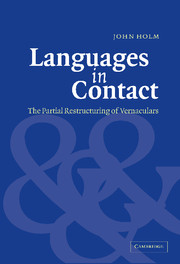3 - The verb phrase
Published online by Cambridge University Press: 22 September 2009
Summary
Introduction
The verb phrase has been of central importance in contact linguistics. While it is true that no particular set of syntactic features can identify a language as having undergone restructuring without reference to its sociolinguistic history, it is also true that the structure of the verb phrase has been of primary importance in distinguishing creole varieties (e.g. Jamaican) from non-creole varieties (e.g. Caymanian English) of the same lexical base. In the Caribbean, the non-creoles have their European system of tense marking (e.g. auxiliary verbs and verbal inflections) more or less intact, whereas the creoles have a radically different way of dealing with tense and aspect. With few exceptions, basilectal Atlantic creole verbs have no inflections; instead, they are preceded by particles indicating tense (the time of an action's occurrence) or aspect (referring to its duration, recurrence, completion, etc.). These often have the outer form of auxiliary verbs from the lexical source language (which occupy a similar position and usually serve a similar function), but semantically and syntactically they are much more like the preverbal tense and aspect markers in many of the creoles' African substrate languages.
The data below show that verbs in the partially restructured languages have few if any inflections – far fewer than their European source languages. In some cases their auxiliary verbs can take on the semantic or even syntactic uses of preverbal markers in fully creolized languages of the same lexical base, giving rise to constructions quite unlike those in their source languages.
- Type
- Chapter
- Information
- Languages in ContactThe Partial Restructuring of Vernaculars, pp. 72 - 91Publisher: Cambridge University PressPrint publication year: 2003



